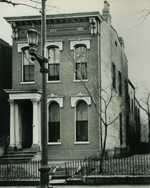Progressivism: 1899-1919
Following Whitsitt’s departure, the seminary trustees sought a leader possessing a statesman’s tact and a moderator’s balance to guide the seminary past the smolder of the Landmark controversy. In June of 1899, the trustees called pastor E. Y. Mullins of the Newton Centre Baptist Church of Massachusetts as Southern’s fourth president.
A distinguished graduate of Southern, Mullins oversaw shifts in the school’s academic policy as the seminary scheduled exams to last for two hours rather than for five. Despite the changes, roughly fifteen percent of all students failed. At Mullins’s instigation, in 1904 the faculty founded a journal,the Review and Expositor. According to Mullins’s biographer William Ellis, the “Seminary organ,” headed by W. O. Carver, spoke in a tone “generally friendly to liberalism” by giving positive reviews to such liberal thinkers as Walter Rauschenbausch, Washington Gladden, and Edmund A. Ross. (1)Mullins, Gambrell, and Whitinghill in Rome
Several other key events occurred in the 1900s. A. T. Robertson published an editorial in the Baptist Argus, a local paper friendly to the seminary, in which he called for a worldwide conference of Baptists. Though others had tentatively discussed the matter, Robertson’s article served to jumpstart the effort. In July 1905, the first conference met in London under the banner of the “Baptist World Alliance.” In this same period, Mullins set out to raise a more adequate endowment for Southern through the Twentieth Century Endowment Campaign, hiring fundraising agents to solicit donations. By the time Mullins’s presidency ended, the endowment had reached a hefty 1.8 million dollars.
Southern began admitting women to seminary classes in the 1900s, though they could not register as official students. The school made provision for women’s education through the Woman’s Missionary Union Training School, which later became the seminary’s Carver School of Church Social Work. Seminary enrollment climbed to 300 in 1909, representing the seminary’s full recovery from the Whitsitt affair. WMU Training SchoolThe faculty produced a good deal of literature in this period, including Mullins’s own Why is Christianity True? and the Axioms of Religion. In 1914, the community celebrated when Robertson published his Grammar of the Greek New Testament in the Light of Historical Research, a project that took twenty-six years to write and a lifetime to fund. The book established Robertson as one of the world’s finest New Testament scholars.
During the First World War, Camp Zachary Taylor trained soldiers in Louisville. Members of the seminary community went there to minister to young soldiers. Old Testament Professor Sampey wrote letters for soldiers unable to pen their own thoughts and received a letter twenty-seven years later from a Kentucky veteran. In a testimony to the character of Southern men, the soldier thanked Sampey for writing to his family during his infirmity. The same spirit of vitality that spurred Sampey to minister characterized the seminary at its fifty year mark.
(1) William Ellis, A Man of Books and a Man of the People, 87.



